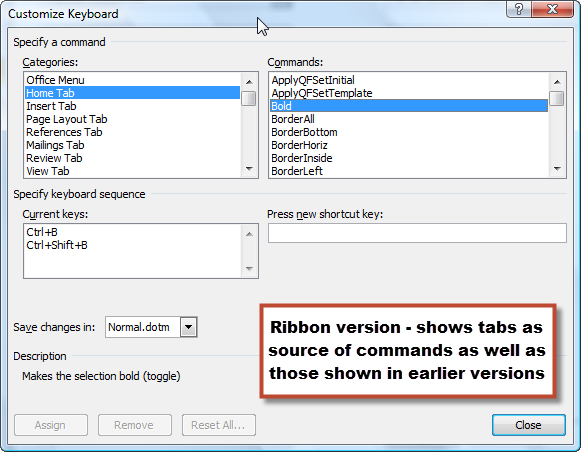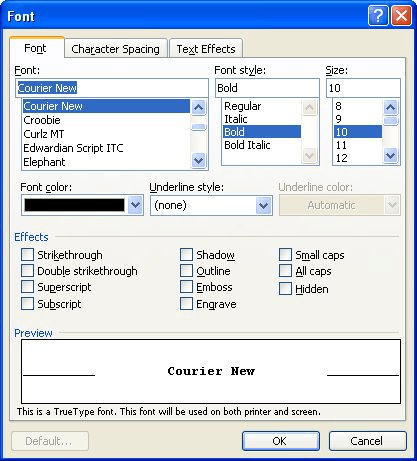Microsoft Word Hot Keys Customize 2016 Mac
Jun 11, 2008 As regular Business Hacks readers know, I'm a big fan of using keyboard shortcuts-especially in Microsoft Word. But there are some program. As of Office 2016, Microsoft has not implemented the Alt-shortcuts for the ribbon. However, there are several dozen other shortcuts that can be used on the Mac. You didn't ask for any specific shortcut so I won't list any here. Also, there are so many that it would be impracticle to list them out. How to use and customize Microsoft Word 2016 keyboard shortcuts Microsoft Word 2016 is the latest version of the widely-used word processor in the MS Office software suite. While this application comes with a number of features that you can easily use with just a few clicks of a mouse, you can also use various keyboard shortcuts, or hotkeys, as.
Use Microsoft Word for the best word processing and document creation. Find out how document collaboration and editing tools can help polish your Word docs. The Customize Keyboard window is how you can control the hotkeys used in Microsoft Word (or whatever other MS Office program you've opened). Choose an option from the Categories: section and then pick an action for the hotkey in the Commands: area. Nov 07, 2019 Microsoft Office 2016 activation keys or merchandise key can be utilized to activate your trial or limited edition of Office 2016 package. After activating the version of Microsoft office, you can avail of complete attributes of a number of the Office 2016 applications such as Microsoft Word 2016, Excel 2016, Outlook 2016, and PowerPoint 2016. Identify and customize keyboard shortcuts in Visual Studio.; 4 minutes to read +4; In this article. You can identify keyboard shortcuts for Visual Studio commands, customize those shortcuts, and export them for others to use. Many shortcuts always invoke the same commands, but the behavior of a shortcut can vary based on the.
-->You can identify keyboard shortcuts for Visual Studio commands, customize those shortcuts, and export them for others to use. Many shortcuts always invoke the same commands, but the behavior of a shortcut can vary based on the following conditions:
Which default environment settings you choose the first time that you open Visual Studio—for example, General Development or Visual C#. (For information about changing or resetting your settings, see Environment settings.)
Whether you've customized the shortcut's behavior.
Which context you're in when you choose the shortcut. For example, the F2 shortcut invokes the
Edit.EditCellcommand if you're using the Settings Designer and it invokes theFile.Renamecommand if you're using Team Explorer.
Regardless of settings, customization, and context, you can always find and change a keyboard shortcut in the Options dialog box. You can also look up the default keyboard shortcuts for several dozen commands in Popular keyboard shortcuts. For a complete list of all default shortcuts (based on the General Development settings), see All keyboard shortcuts.
If a shortcut is assigned to a command in the Global context and no other contexts, that shortcut will always invoke that command. But a shortcut can be assigned to one command in the Global context and a different command in a specific context. If you use such a shortcut when you're in the specific context, the shortcut invokes the command for the specific context, not the Global context.
Note
Your settings and edition of Visual Studio might change the names and locations of menu commands and the options that appear in dialog boxes. This page is based on the General Development settings profile.
Identify a keyboard shortcut
On the menu bar, choose Tools > Options.
Mac office 2016 64 bit. Expand Environment, and then choose Keyboard.
In the Show commands containing box, enter all or part of the name of the command without spaces.
For example, you can find commands for
solutionexplorer.In the list, choose the correct command.
For example, you can choose
View.SolutionExplorer.If the command has a keyboard shortcut, it appears in the Shortcut(s) for selected command list.
Customize a keyboard shortcut
On the menu bar, choose Tools > Options.
Expand Environment, and then choose Keyboard.
Optional: Filter the list of commands by entering all or part of the name of the command, without spaces, in the Show commands containing box.
Updated mac os catalina and now microsoft office not working in windows 10. I’m able to whizz through photo edits in no time at all thanks to a combination of a bunch of presets I’ve created, plugins I’ve added and familiarity with the UI.The app is 64-bit, so ought to still run in Catalina, but some of my plugins are flagged. I’ve used Lightroom since version 1, and love the app. The UI changes between versions 1 and 3 have been incremental, so there’s never been a big new learning curve.
In the list, choose the command to which you want to assign a keyboard shortcut.
In the Use new shortcut in list, choose the feature area in which you want to use the shortcut.
For example, you can choose Global if you want the shortcut to work in all contexts. You can use any shortcut that isn't mapped (as Global) in another editor. Otherwise, the editor overrides the shortcut.
Note
You can't assign the following keys as part of a keyboard shortcut in Global:
- Enter, Tab, Caps Lock
- Print Scrn/Sys Rq, Scroll Lock, Pause/Break
- Insert, Home, End, Page Up, Page Down
- The Windows logo key, the Application key, any of the Arrow keys
- Num Lock, Delete, or Clear on the numeric keypad
- The Ctrl+Alt+Delete key combination
In the Press shortcut key(s) box, enter the shortcut that you want to use.
Note
You can create a shortcut that combines a letter with the Alt key, the Ctrl key, or both. You can also create a shortcut that combines the Shift key and a letter with the Alt key, the Ctrl key, or both.
If a shortcut is already assigned to another command, it appears in the Shortcut currently used by box. In that case, choose the Backspace key to delete that shortcut before you try a different one.
Choose the Assign button.
Note
If you specify a different shortcut for a command, click Assign, and then click Cancel to close the dialog box, the shortcut you assigned is not reverted.
Share custom keyboard shortcuts
You can share your custom keyboard shortcuts by exporting them to a file and then giving the file to others so that they can import the data.
To export only keyboard shortcuts
On the menu bar, choose Tools > Import and Export Settings.
Choose Export selected environment settings, and then choose Next.
Under What settings do you want to export?, clear the All Settings check box, expand Options, and then expand Environment.
Select the Keyboard check box, and then choose Next.
In the What do you want to name your settings file and Store my settings file in this directory boxes, either leave the default values or specify different values, and then choose Finish.
By default, your shortcuts are saved in a file in the %USERPROFILE%DocumentsVisual Studio 2017Settings folder. The name of the file reflects the date when you exported the settings, and the extension is .vssettings.

By default, your shortcuts are saved in a file in the %USERPROFILE%DocumentsVisual Studio 2019Settings folder. The name of the file reflects the date when you exported the settings, and the extension is .vssettings.
To import only keyboard shortcuts

Microsoft Word Hotkeys Customize 2016 Mac Download
On the menu bar, choose Tools > Import and Export Settings.
Choose the Import selected environment settings option button, and then choose Next.
Choose the No, just import new settings, overwriting my current settings option button, and then choose Next.
Under My Settings, choose the file that contains the shortcuts that you want to import, or choose the Browse button to locate the correct file.
Choose Next.
Under Which settings do you want to import?, clear the All Settings check box, expand Options, and then expand Environment.
Select the Keyboard check box, and then choose Finish.